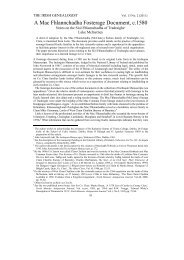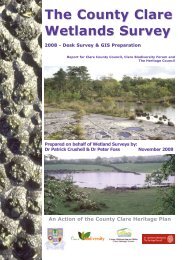Documents from the Thomond Papers at Petworth House Archive1 ...
Documents from the Thomond Papers at Petworth House Archive1 ...
Documents from the Thomond Papers at Petworth House Archive1 ...
Create successful ePaper yourself
Turn your PDF publications into a flip-book with our unique Google optimized e-Paper software.
<strong>Documents</strong> <strong>from</strong> <strong>Thomond</strong> <strong>Papers</strong>, <strong>Petworth</strong> <strong>House</strong> Archive<br />
Sir Dermot received <strong>the</strong> dignity baron of Gleanomalun on 23 September<br />
1622 by James I and his two sons, Albert and Francis, were recognised as<br />
heirs and granted deniz<strong>at</strong>ion, both having been born on <strong>the</strong> Continent. 128<br />
In 1624 Sir Dermot, who was described as an ‘Irishman of <strong>the</strong> Order of<br />
Cal<strong>at</strong>rava’ 129 was in correspondence with <strong>the</strong> pope and his cardinal secretary<br />
of st<strong>at</strong>e, Ludovico Ludovisi. The pope forwarded a letter of recommend<strong>at</strong>ion<br />
to Sir Dermot for him to procure favour <strong>at</strong> <strong>the</strong> Spanish Court. 130 Pope<br />
Urban VIII held Sir Dermot in high esteem on account of <strong>the</strong> ‘gre<strong>at</strong> merit<br />
acquired by him in helping <strong>the</strong> C<strong>at</strong>holic religion.’ 131<br />
By 1627 Sir Dermot was seeking a favourable return to Britain and had<br />
entered into correspondence with English officials <strong>at</strong> Westminster to assert<br />
his desire to return and serve under King James I, claiming to have ‘never<br />
born arms against <strong>the</strong> king’. 132 We learn th<strong>at</strong> Sir Dermot was considered<br />
useful as he had ‘correspondence with all Europe’ and had rejected offers<br />
<strong>from</strong> <strong>the</strong> king of Spain to be made an earl or marquis on <strong>the</strong> grounds th<strong>at</strong><br />
foreign conferment of title would offend King James. He also rejected<br />
<strong>the</strong> Emperor’s offer to raise a regiment of 3,000 men and make him a<br />
member of <strong>the</strong> imperial Privy Council and Council of Wars. 133 Of particular<br />
relevance to Sir Dermot’s petitions of 1630–31, is <strong>the</strong> record th<strong>at</strong>:<br />
…He is near cousin to Lord <strong>Thomond</strong> [Henry O’Brien], who is <strong>at</strong><br />
London. Sir Barnaby O’Brien, bro<strong>the</strong>r to <strong>the</strong> Earl, holds all Lord<br />
Dermot’s younger daughter Isabella was a nun of <strong>the</strong> Order of St Benedict and, along with<br />
Maria and Jeanne, was granted a half-yearly pension of 400 livres in 1642 in Brussels. See<br />
Jennings (ed.), Wild Geese, p. 357.<br />
128 Calendar of <strong>the</strong> St<strong>at</strong>e <strong>Papers</strong> Rel<strong>at</strong>ing to Ireland, of <strong>the</strong> Reigns of James I, 1615–1625, (London,<br />
1880), p. 392. It has been argued elsewhere th<strong>at</strong> <strong>the</strong> expansion of titles of honour in Ireland<br />
by <strong>the</strong> Stuart Kings was based on practical consider<strong>at</strong>ions. The peerage in Ireland was gre<strong>at</strong>ly<br />
enlarged in <strong>the</strong> early 1600s as a means to curtail <strong>the</strong> influence of an independent C<strong>at</strong>holic<br />
powerbase and plac<strong>at</strong>e it and to harness <strong>the</strong> Irish aristocracy more closely to <strong>the</strong> Crown. See<br />
Charles R. Mayers, ‘The Early Stuarts and <strong>the</strong> Irish Peerage’ in The English Historical Review,<br />
lxxiii, 287 (April 1958), pp 227–251, p. 227.<br />
129 Sir Dermot petitioned for this knighthood after his rel<strong>at</strong>ives in Ireland procured him <strong>the</strong><br />
ecclesiastical endowment of Tomgraney (i.e. Tuamgraney) which had been redeemed in<br />
perpetuity by C<strong>at</strong>holic gentlemen <strong>from</strong> <strong>the</strong> possession of <strong>the</strong> English Crown for a sum of money<br />
‘fearing least <strong>the</strong> endowment might fall into <strong>the</strong> hands of heretics’. As married men could not<br />
hold an ecclesiastical income unless <strong>the</strong>y also held a military order, Sir Dermot engaged a public<br />
notary to record <strong>the</strong> <strong>at</strong>test<strong>at</strong>ion of his character by several Irish notables, and was granted <strong>the</strong><br />
Order of Cal<strong>at</strong>rava sometime between 1616 and 1618. The endowment of Tomgraney was worth<br />
2000 crowns yearly in 1615. See Jennings (ed.), Wild Geese, pp 145–46, p. 163.<br />
130 Giblin C<strong>at</strong>haldus, ‘C<strong>at</strong>alogue of m<strong>at</strong>erial of Irish Interest in <strong>the</strong> Collection Nunzi<strong>at</strong>ura di<br />
Fiandra, V<strong>at</strong>ican Archives: Part 1, Vols. 1–50’ in Collectanea Hibernica, i (1958), pp 7–136,<br />
pp 36, 59, 60.<br />
131 C<strong>at</strong>haldus Giblin, OFM, ‘C<strong>at</strong>alogue of m<strong>at</strong>erial of Irish interest in <strong>the</strong> collection Nunzi<strong>at</strong>ura<br />
di Fiandra, V<strong>at</strong>ican Archives: Part 8, Vols. 137A-147C’, (1969), pp 66–67.<br />
132 Calendar of <strong>the</strong> St<strong>at</strong>e <strong>Papers</strong> Rel<strong>at</strong>ing to Ireland, Preserved in <strong>the</strong> public Record Office, 1647–1660,<br />
p.102.<br />
133 Ibid.<br />
29

















